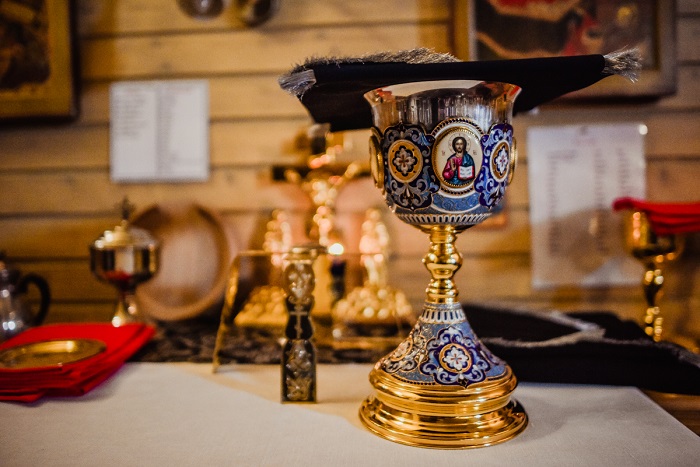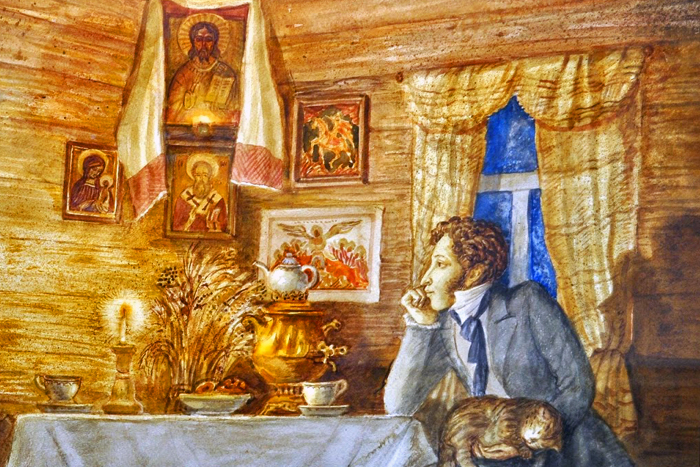
The Orthodox Church holds an amazing and sublime service called the Liturgy of the Presanctified Gifts during the Great Lent. This Liturgy is ‘abridged’, that is, it doesn’t contain the Anaphora along with many other prayers typical of the Liturgies of St. John Chrysostom and St. Basil the Great. There is a question concerning this Liturgy: Does wine turn into the Blood after the Body of Christ has been put into the Chalice? Not all Orthodox theologians agree on the answer to this question. This post doesn’t aim to argue in favor of a certain answer. It merely attempts to voice various positions on this issue.
Wine Does Not Turn into Blood: Contemporary Practice of the Russian Orthodox Church
1. The wine and the water in the Chalice are consecrated but not transelemented by touching the Holy Gifts. Saint Symeon of Thessalonica does not use the term transelementation in his description of the Liturgy of the Presanctified. The fact that priests drink consecrated wine from the Chalice is meant to maintain the rite of communion of the clergy.
2. The Book of Needs by Peter Mogila claims that the Chalice contains wine, not the Blood. The wine is used for washing the officiant’s lips “for the sake of preserving the ceremony” (Met. Peter Mogila, The Book of Needs. Kiev, 1646. Reprinted in Kiev in 1996. Vol. 1. p. 253).
3. The Pontifical of 1675 and the Service Book of 1676 edited by Monk Euthymius forbid a deacon or a priest if he serves without a deacon to drink from the Chalice at the Liturgy of the Presanctified. It is explained by saying that the wine in the Chalice is consecrated but not turns into the Blood of the Lord.
4. If wine does turn into the Blood of Christ at the Liturgy of the Presanctified, why call it Presanctified if the wine turns into the Blood?
5. The absence of all kinds of liturgical and sacramental prayers, as well as the Anaphora necessary for transelementation of the Gifts is another case in point – the Sacrament of Eucharist doesn’t occur and therefore wine doesn’t turn into the Blood.
6. Turning wine into the Blood of Christ through contact with the Presanctified Bread (which in the ancient times was not soaked in the Blood, to boot) was borrowed from the Latin Rite, which had the same practice (Vogel C. e. a. Le Pontifical Romano-germanique du dixième siècle. Vat., 1963. T. 2. P. 92-93. (ST; 227)).
7. If we accept the opinion that wine turns into the Blood thanks to mere touching the Presanctified Lamb without a prayer, then we would undermine the dogmatic teaching on Sacraments, which states that there has to be a prayer, a request, and an invocation of the Holy Spirit for any Sacrament to take place. Otherwise, it starts to look like some kind of magic.
8. If we suppose that the Russian Church had always adhered to the position that wine turns into the Blood of Christ during the Liturgy of the Presanctified, why then didn’t Old Rite believers use the innovations of Peter Mogila and the practice of Nikonians as a pretext to criticize the custom they hadn’t known before? However, Old Rite believers have never criticized the Russian Orthodox Church with regard to this issue.

Proponents of the Position that Wine Does Turn into Blood: Practice of Greek Orthodox Churches
1. Wine turns into the Blood of Christ thanks to its touching the Lamb, which has been consecrated beforehand. This is a practice known to the Orthodox Church since ancient times. Greek Orthodox Churches follow this practice, as had the Russian Church until the era of Peter Mogila, who was under strong Catholic influence.
2. The transelementation of wine into the Blood of Christ is confirmed by a letter of Michael III of Anchialus, the Patriarch of Constantinople (1169-1177) to Bishop Paul of Callipolis, which reads, “The Liturgy of Presanctified is held only to consecrate the Holy Chalice.” (De excerptis liturgicis e Typico monasterii Casulani // Mai. NPB. 1905. T. 10/ 2. P. 167-171). The consecration of the Chalice is nothing other than the transelementation of wine into the Blood of the Lord.
3. There is another proof, provided by another Patriarch of Constantinople, Michael II Oxeites (1143-1146), who wrote a special Explanation at the emperor’s request. It reads that the officiant “puts the Presanctified and changed Holy Bread into the Sacramental Cup, and that is how wine is regarded to be changed and is changed indeed (μεταβάλλεται κα πιστεύεται μεταβάλλεσθαι) into the Holy Blood of the Lord.” (RegPatr, N 1021).
4. The tradition of preserving the Lamb without soaking it in the Holy Blood has started to disappear by the 14th century. They began filling the Holy Lamb with the Blood of Christ, and that was why the question of how and why the Chalice is consecrated was no longer meaningful. Now wine did not only touch the consecrated Lamb but also mixed with the Holy Blood, which is proven by the account of St. Symeon of Thessalonica, a famous liturgist of the 15th century. He writes, “When the upper part (of the Presanctified Lamb) is in the Cup, the contents of the Cup are consecrated thanks to contact (ἁγιασθῶσι τῷ μετοχῇ)… the officiant partakes of the Bread and the Cup, and gives it to those who wish to take communion… It is not thanks to the invocation of the Holy Spirit and the sign of the cross that the contents of the Chalice are consecrated at the Liturgy of the Presanctified but thanks to their contact and mixing with the life-giving Bread, which truly is the Body of Christ and which is mixed with the Blood (of Christ)” (PG. 155. Col. 909).
5. Peter Mogila was the first Orthodox author who refused to admit that wine turns into the Blood of Christ during the Liturgy of Presanctified. The reason was strong criticism of the Orthodox practice, voiced by ex-Archimandrite Cassian (Sakovič) who had defected to the Unia. Peter Mogila was Sakovič’s contemporary. He basically agreed with his arguments and included a chapter into his Book of Needs, in which he aimed to amend the Liturgy of Presanctified by claiming that the wine in the Chalice wasn’t Blood. The order of communion was ostensibly retained so as not to break the rite.
6. Peter Mogila’s amendments were later adopted by Russian printed service books and Pontificals, which point out that although wine is consecrated by the presence of the Gifts but it isn’t transelemented nevertheless. Later, there was a special note that a deacon wasn’t allowed to drink from the Cup until after he ate the Gifts at the end of the Liturgy, and the same was true of a priest who celebrated the Liturgy without a deacon (See Karabinov, 1915. pp. 957-964).
7. Old Rite parishes of the Russian Orthodox Church use the full rite of communion at the Liturgy of Presanctified.
8. Practically speaking, if a deacon partakes only of dry Presanctified Gifts and doesn’t partake of the Cup, it may cause him to cough out some particles that he hasn’t consumed properly while voicing the ectenias.
Here are the key points of both sides: those who believe that wine turns into the Blood of Christ during the Liturgy of Presanctified and those who do not. The final decision on this argument will have practical repercussions for the communion of the clergy or the possibility of giving communion to infants during the Liturgy of Presanctified. There is no pan-Orthodox consensus on this issue right now. Therefore, we should stick to the tradition upheld by our own Church and obey the local ecclesiastical hierarchy. Hopefully, the long-awaited Ecumenical Council will resolve this issue.



